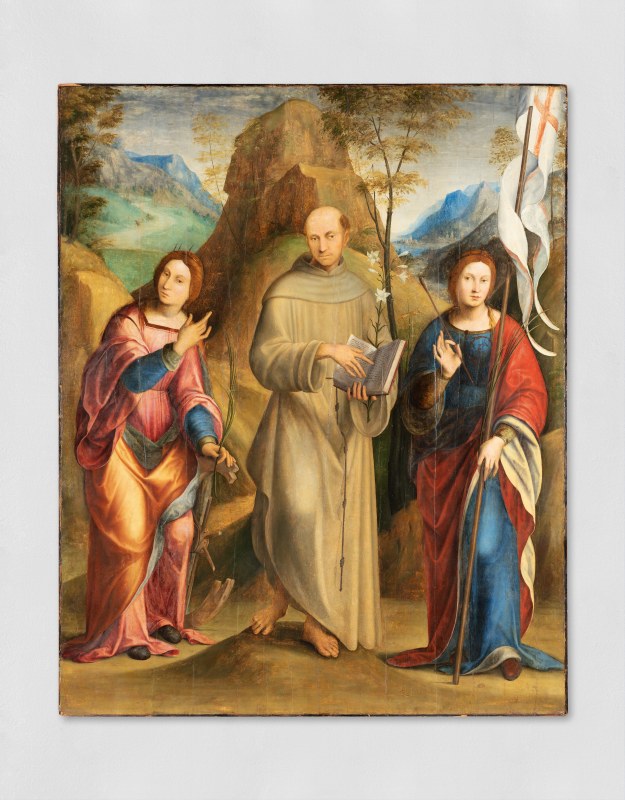-
Biography
Lorenzo Costa (Ferrara, Italy 1460 - Mantua, Italy 1535)
Born in Ferrara in 1460, he was influenced, possibly trained, by Ercole de' Roberti, the leading Ferrara painter of the Cosmè Tura painting school in the late 15th century. Costa was one of the first members of the Ferrara-Bologna School to adopt a soft and atmospheric style.
In 1483, Costa probably settled in Bologna, where he worked until 1506, sporadically visiting Ferrara and Rome.
Immediately after the expulsion of the Bentivoglio family from Bologna, in 1506, he was summoned to Mantua as court painter, to succeed Andrea Mantegna.
He remained the city’s leading artist until the arrival of Giulio Romano in 1524, but little remains of his extensive work. His mature style often recalls that of Perugino, with a delicate sensitivity for landscapes; it has been suggested that he inspired Giorgione.
His most ambitious works were the altarpieces created for churches in Bologna. These include his earliest dated work, the Bentivoglio altarpiece of 1488. Later works, such as the altarpiece in the Gallery, The Virgin and Child with Saints, are more influenced by Francia and Perugino.
In 1506, he moved to Mantua as court painter, called by Isabella d'Este; here he was drawn to the art of Mantegna.
Costa's last painting is The Enthroned Virgin and Saints for the Church of S. Silvestro signed and dated by the painter in 1525. This artwork represents a memorable synthesis of the artist’s last studies before his death in Mantua in 1535.
Photo UniCredit Group (Sebastiano Pellion di Persano)
-
Works
Lorenzo Costa: Italian, 1460-1535
A painter from Ferrara, one of the most important artists of the Ferrara and Mantua schools of the sixteenth century.Join our mailing list
* denotes required fields
In order to respond to your enquiry, we will process the personal data you have supplied in accordance with our privacy policy.


![An oil painting of Saint Catherine, Anthony of Padua and Ursula, set in a natural landscape. Saint Catherine is seen on the left dressed in pink, blue and orange. At her feet, a broken spiked wheel and sword. The wheel is the instrument of torture that Catherine was condemned to death on by the Roman Emperor Maxentius [306-312] for her strong Christian beliefs. According to legend, the wheel broke when she touched it, so she was beheaded with the sword. In the Centre, Saint Anthony of Padua, dressed in a monk's robe, is holding a white lily and an open book. According to legend, the book represents an event when Anthony had a psalter (a book of psalms) stolen in Bologna, which is the origin of calling upon St. Anthony when something is lost or stolen. The lily represents purity and his battle against the devil. Saint Ursula, on the right, is dressed in red, blue and white, holding a flag and a single arrow. The legendary Romano-British Christian saint is said to have died along with an anonymous group of holy virgins in Cologne. Saint Ursula was fatally shot with an arrow during a pan-European pilgrimage by the leader of the Huns', a nomadic people who lived in Central Asia who had besieged Cologne. Artwork details: Artist: Lorenzo Costa. Artwork title: S. Antonio da Padova e le Sante Caterina e Orsola. Artwork year: c.1500-25. Artwork medium: Oil on board. Artwork dimensions: 217 x 175.5 x 2.5 cm.](https://artlogic-res.cloudinary.com/w_600,c_limit,f_auto,fl_lossy/artlogicstorage/unicredit/images/view/0c15ae9dbec69ef1cb614c876caf1fdbj/unicreditartcollection-lorenzo-costa-s.-antonio-da-padova-e-le-sante-caterina-e-orsola-c.1520.jpg)
